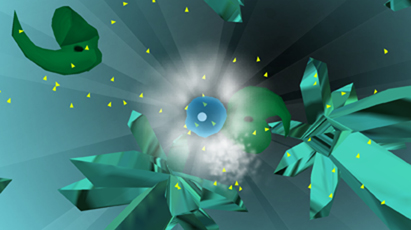Athens, Ga. – Having successfully navigated her way through select high school classrooms in North Georgia for more than two years while capturing the attention of hundreds of students, “Osy Osmosis” has now entered the competitive world of mobile apps.
Developed by a group of researchers, educators and software developers at the University of Georgia, Osy is a fun, educational game designed to teach the principle of osmosis, or how water moves in and out of cells.Osy was released this month on Apple’s iTunes App store for the iPhone/iPod Touch ($1.99) and also as a HD version for the iPad ($3.99).To link to Osy, see http://www.osyosmosis.com/.
Players help Osy stay safe by keeping her in balance with her environment as she navigates her universe and collects stars. The game’s technology was initially developed as part of a five-year study, funded by the National Institutes of Health Science Education Partnership Awards Program, to create and evaluate 3D animated biology lessons for high school students. Osy was the brainchild of Casey O’Donnell, an educational gaming expert in the Grady College of Journalism and Mass Communication.
“Osy does an incredible job of introducing osmosis to students,” said Jim Moore, one of the principal investigators on the project.”After trying unsuccessfully to help my daughters understand osmosis by talking through the potato slice experiment typically used in science labs, I simply turned them loose with Osy.It worked brilliantly.”
During field-testing of the educational software in classrooms, the creators found that the interactivity provided by the game helped boost the students’ interest level in the topic.
“When you first see students working with Osy in a biology classroom, their high level of engagement is striking. This seems to be true regardless of the level of the biology class. But in our follow-up to playing the game, many students express an understanding of how key factors, such as concentration gradients, are important to osmosis. Osy seems to support students to create visualizations of osmosis that make a relatively abstract biological process much more concrete,” said Steve Oliver, a principal investigator on the project.
Osy is the first scientifically based educational video game to be commercially released by IS3D LLC (http://is3donline.com/), a partnership of eight UGA faculty and staff members who created the company to market their products.The board members are four professors and a staff member from the College of Veterinary Medicine who areTom Robertson, Dr. Jim Moore, Dr. Scott Brown, Dr. Cynthia Ward and instructional designer Flint Buchanan.The other partners are Steve Oliver, a professor from the College of Education; Casey O’Donnell, a telecommunications professor from the Grady College of Journalism; and Mike Hussey, a theater professor from the Franklin College of Arts and Sciences.
The Osy Osmosis software was licensed by the University of Georgia Research Foundation, Inc. to IS3D, with commercial development made possible by support from the Georgia Research Alliance VentureLab and the founders of IS3D LLC.All profits from Osy will go toward the creation of other educational games and interactive software.
“Over the past two years, our project has flourished and grown to include more than a dozen UGA graduates and graduate students who are working to create innovative software for science education. Moving forward, the biggest challenge will be to secure funding to keep these talented young people. This is why we formed IS3D, as it allows us to apply for small business grants,” explained Robertson, who is CEO of the partnership.”UGA has been incredibly supportive. Derek Eberhart of UGA’s Technology Commercialization Office, Stefan Schulze of the Georgia BioBusiness Center and Cem Oruc of the Georgia Small Business Development Center have all been incredibly helpful. We’ve had encouraging scores on both our academic and small business grant applications and everyone is working hard to make UGA a leader in the development of innovative science education materials.”








